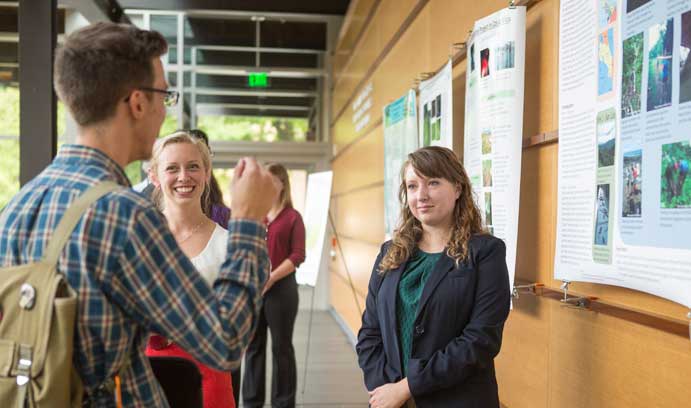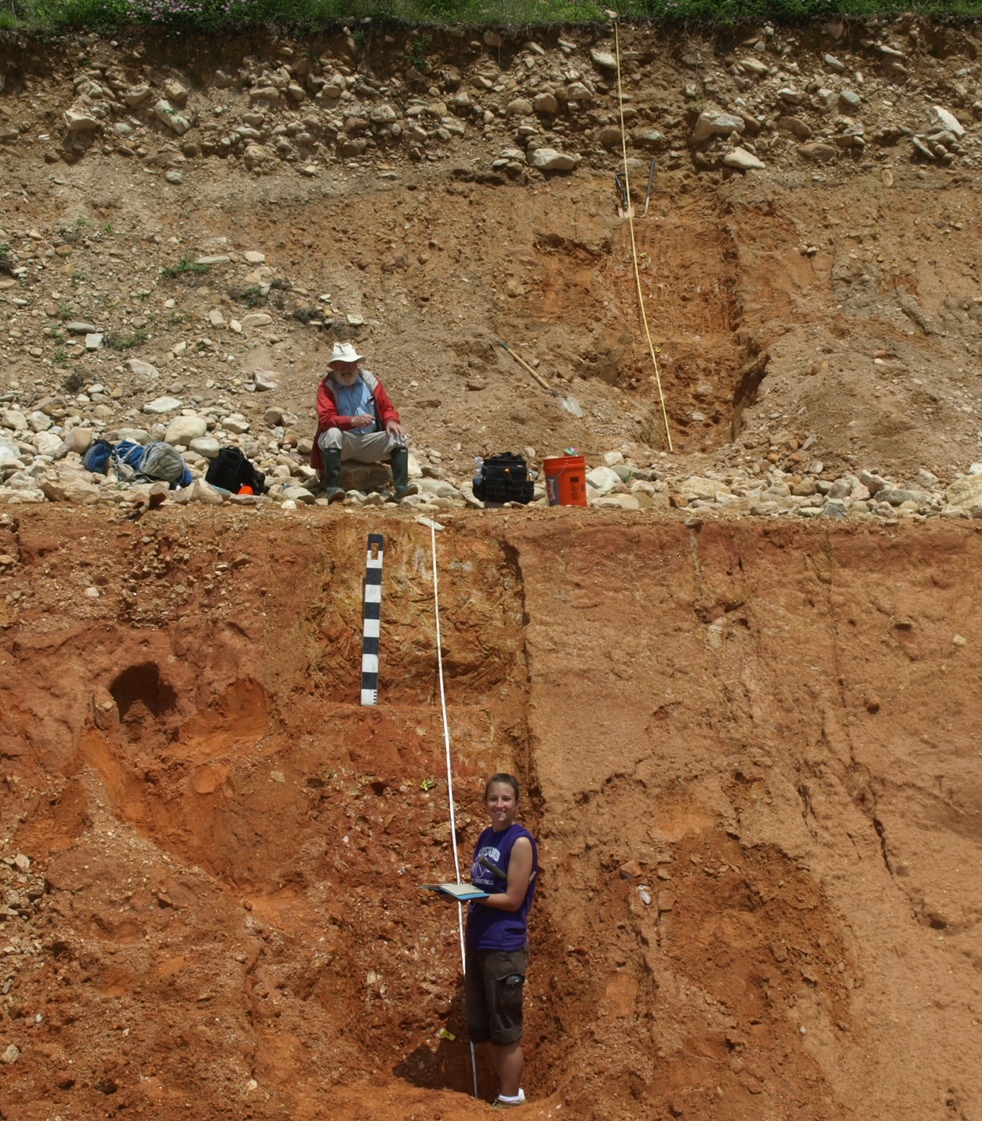From soils to storms to reforestation in Costa Rica

Ashley Kreitz ’14 (left) and Katie Kimball ’15 (right) explain their work to a visitor at a symposium of undergraduate student researchers at the STEPS building.
Ashley Kreitz and Katie Kimball made their first trip to Central America in January 2013 when they enrolled in a course called “Sustainable Development: The Costa Rica Experience.”
The two seniors returned last summer, this time with the Lehigh in Costa Rica Internship Program, to spend seven weeks working on reforestation and conservation projects.
“This was a great opportunity,” said Kimball, who, like Kreitz majors in earth and environmental sciences. “When you go to a prestigious university, you can get caught in a bubble. There’s so much more to the world.
“In Costa Rica, we had to adapt and make changes. We learned a lot from the local people. Some of them have no formal education but they know so much about the environment because they live and work there. I was kind of humbled.”
Kreitz and Kimball and two dozen other students recently presented posters about the projects they conducted last summer through three undergraduate research programs. The symposium was held in the concourse of the STEPS building.
Kreitz, Kimball and four other students took part in the Lehigh in Costa Rica Internship Program, which also receives funding from the Lee Iacocca International Internship program.
A second group of students completed projects through the EI-STEPS (Environmental Initiative and Science, Technology, Environment, Policy and Society) Summer Research Internship Program. A third group received support from the Sustainable Development Program through the university’s new Mountaintop Initiative.
Restoring flora, protecting fauna
“The Costa Rica Experience” winter program allows a select group of students to travel for two and one-half weeks in Costa Rica over winter break. Open to students from all majors, the course has been offered since 1997.
The Lehigh in Costa Rica Internship Program, offered for seven weeks each summer since 2012, gives students the chance to work on sustainable development and service projects.
Kimball’s project was called “Tropical Reforestation and Conservation in Costa Rica,” while Kreitz’s was called “Monitoring and Mapping a Reforestation Project in Costa Rica.”
The projects involved mapping streams and mapping the perimeters of plots of land on the Osa Peninsula, where the Costa Rican government is attempting to reintroduce native tree species through the Osa Conservation Project.
“Invasive species took over the land after it was cleared for cattle ranching,” says Kreitz. “Now the government is trying to restore the native trees. We tagged trees and tracked their growth.”
Two of the native species are the large, umbrella-shaped Guanacaste, the national tree of Costa Rica, and the Ronron, a flowering tree in the cashew family.
Kimball and Kreitz were both advised by Don Morris, EI co-director and associate professor of earth and environmental sciences.
Both students also took part in Costa Rica’s efforts to protect its population of sea turtles. Wildlife workers are identifying and tagging female turtles and placing eggs from washed-away nests in hatcheries.
Preparing for stronger storms
Peter Phelps ’15, an IDEAS major (Integrated Degree in Engineering, Arts and Sciences), spent the summer closer to home, conducting a study titled “Storms and the Cost of Repair in the Mid-Atlantic Region.”
Phelps used the Terrestrial Ecosystems Model (TEM) model to estimate the increase in repair costs due to what is projected to be an increased intensity of future storms in the states of Pennsylvania, New Jersey, Delaware, New York, Maryland and Virginia.
In his poster, Phelps cited a study by his adviser, Ben Felzer, assistant professor of earth and environmental sciences, which predicts an increase of 17 percent in the intensity of future storms in the six states.
“For my project,” said Phelps, “I wanted to look at the intersection of the environment and the economy. This was the first time I applied the code I wrote for the TEM-Hydro Model. The code is a huge C++ program. I wrote one block of it.”
In his study, which was sponsored by the EI-STEPS Summer Research Internship Program, Phelps provided the Tem-Hydro Model with data sets of climate statistics. The model used physical equations to produce output variables, enabling Phelps to estimate that a 17-percent increase in storm intensity would cause $61 million more in damage each year in the Mid-Atlantic states.
A window on climate history
Taylor Cummins, who also had an EI-STEPS internship, studied two soil deposits in Pennsylvania whose high iron content give them a deep red color that is more commonly found in soils in the earth’s tropical regions.
Cummins earned a B.S. in environmental engineering last May and is staying a fifth year to complete a B.S. in earth and environmental sciences. Her poster was titled “Iron Chemistry Analysis and Pedogenesis of Two Late Cenozoic Paleosols in East-Central Pennsylvania,” and her advisers were Frank Pazzaglia and Stephen Peters, professors of earth and environmental sciences.
By studying buried soils, or paleosols, says Cummins, scientists can draw conclusions on the paleoenvironmental conditions that prevailed when the soils were formed and exposed to the elements at the surface.
Cummins analyzed soils that she dug from a variety of depths at two sites: on the north slope of South Mountain near Emmaus, Pa., and at Valley Quarries in Mainsville, Pa., southwest of Harrisburg. After doing a particle size analysis, she crushed some of the soils to a fine powder and conducted a leachate test, mixing the soil with chemicals to determine iron concentration.
The soil at the Emmaus site, says Cummins, was formed when sediment was deposited by a glacier flowing through the mountain. The soil at the Mainsville site was formed as a result of erosion caused by water.
Cummins is expanding her research this year. She plans to compare the iron ratio of soil taken from a site on the Maryland coast with the iron ratios from the two Pennsylvania sites.
“We think these soils are between 300,000 and 1 million years old,” she says. “That’s the last time this part of Pennsylvania was warm and humid enough to produce this kind of red soil.”
Story by Kurt Pfitzer
Posted on:


